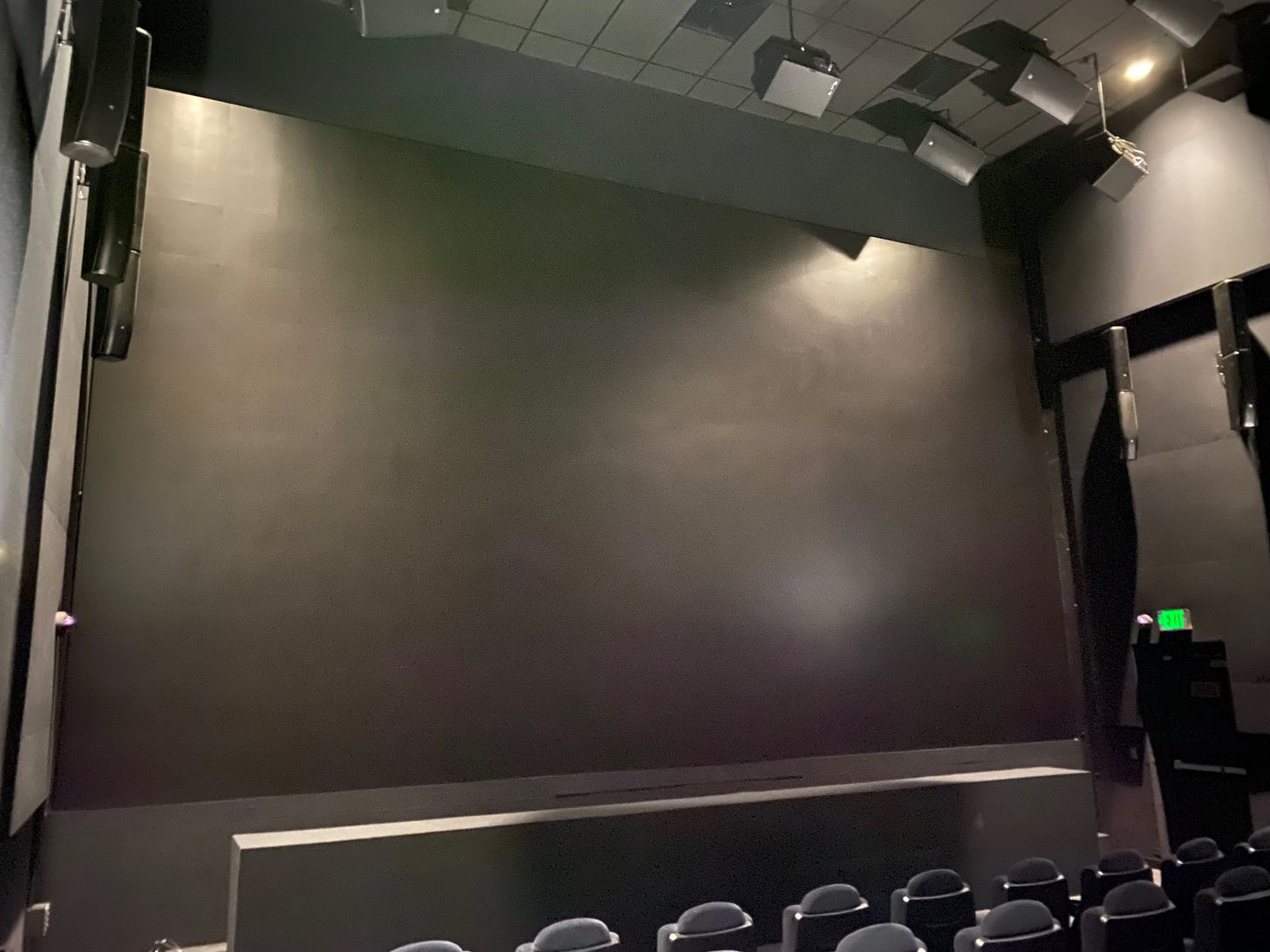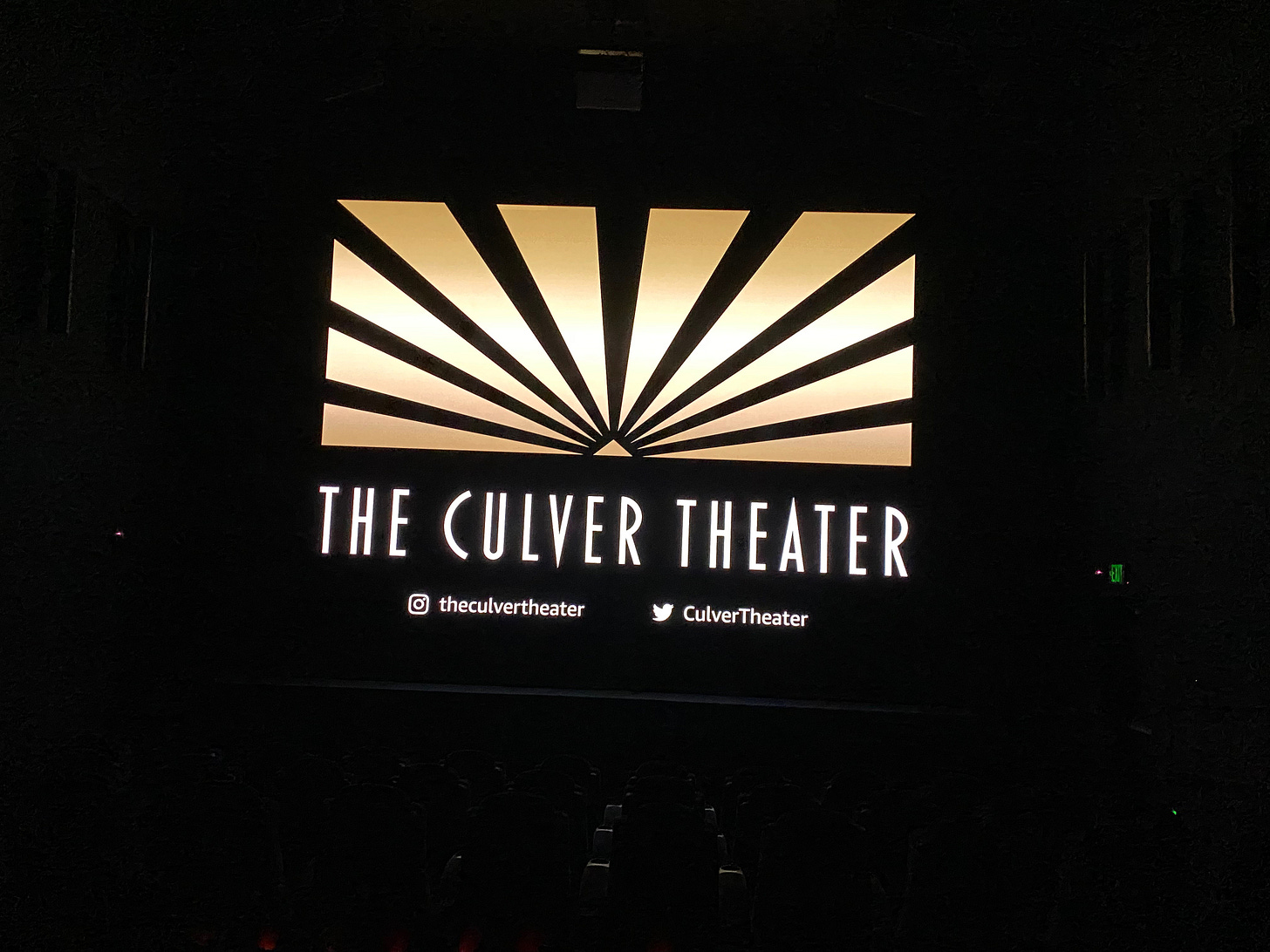The latest cinema projector isn't a projector at all
Notes from my first experience watching a movie via Samsung Onyx, the "LED Wall" that displays movies instead of a projector at Amazon's Culver City movie theater
This afternoon, I went to see Argentina, 1985 at The Culver Theater in West LA. This is corporate titan Amazon’s first-ever cinema concept, actually a refinishing of the former ArcLight Culver City with a reduced screen count. (The rest of the auditoriums, I am told, have been turned into postproduction facilities for Amazon Studios.) I’ve attended this theater in its former incarnations – both ArcLight and Pacific – plenty of times over the years. Most of the setup is the same, just with aesthetic retouches; in fact, the bathrooms and the old ArcLight seats remain. But there is one major difference: five of the six screens feature Samsung Onyx Cinema LED presentation, rather than the Sony 4K projection previously installed here.
If you don’t obsess over new movie exhibition technologies, like I do, then you probably haven’t heard of Samsung Onyx. Or maybe you aren’t sure whether you have or not. After all, the number of different presentation options littered all over theater showtime apps – IMAX, Dolby Cinema, Dolby Atmos, DTX, RealD, ScreenX, DBOX, PRIME, and on and on – has grown exponentially in recent years. Long gone are the days when “70MM” and “THX” were the only big differentiators in the newspaper listings. Many casual moviegoers don’t know or care the difference between all of the available options, beyond how much of a surcharge is tacked onto their ticket price. I have a confession: when The Culver Theater (re-)opened a couple months ago, I had no idea what Samsung Onyx was, either.
When a friend forwarded me a tweet from one of the first patrons of the reimagined Culver Theater that claimed there were “no projectors, just LED walls,” I was immediately skeptical. Surely, there had to be projectors, but they must have been elegantly hidden in those newfangled projection “boxes” that attach to the ceiling, rather than inside the old booth, I thought. After all, even if Amazon had gone to the immense expense of installing LED screens at the head of each theater, I reckoned, there was no possible way they could then plumb the 0’s and 1’s from a DCP file through a server and onto what would effectively be an HDR display… Was there?
Yes, yes there was. As the reborn Culver Theater’s website took shape, they soon began affixing the Samsung Onyx logo to showtimes for movies playing in five of their six auditoriums (they have retained a conventional digital projector in one room). Unlike the resolution of the MicroLED screens themselves, the web graphic was hard to decipher, but I quickly figured out what it represented.
That led me to Samsung’s website detailing the capabilities and benefits of this new cinema technology. There were press pull-quotes from filmmakers and cinematographers and post-production experts touting its virtues. Indeed, Onyx does not involve a projector at all; rather, it uses up to 34 feet of interconnected LED panels to bring cinematic images to life in the same manner as the jumbotron at a sporting event. And while not widely adopted, the technology already has a footprint of about 15 theater locations worldwide. Little did I know, an Onyx screen had already been demoed at the Pacific Winnetka cinemas in Chatsworth, which were shuttered during the pandemic lockdown and never reopened.
As I continued my desk research on Onyx, all I could think about were Quentin Tarantino’s comments on digital projection at the 2014 Cannes Film Festival. “As far as I’m concerned, digital projection is the death of cinema,” Tarantino declared, going on to proclaim that “digital projection is just television in [a] cinema.” His comments were so widely publicized that they would lead him to take control of the daily business of Los Angeles’ New Beverly Cinema, which he had previously simply financially supported, so that he could implement a “film-only” policy and remove the occasionally-used digital projector from the revival house’s booth. But standard digital projection bears a lot more in common with traditional film projection than Onyx does. Sure, digital projection removes the physicality of the image and the shutter, but the geography of the apparatus – a device beaming light onto a screen at a fixed distance, from behind the spectator – remains the same. By comparison, Onyx really is “TV in public.”
That’s the reason Onyx fascinates me: it is a truly different experience from what we’ve seen before in public cinema exhibition, save for – I suppose – a few experimental and non-profit venues where movies are screened on very large consumer televisions off DVDs, Blu-Rays, and/or PC files. Yes, there is still a screen at the head of a theater where a movie is displayed at roughly the same dimensions as what we’re used to, and the audience still sits (mostly) silent and faces it. But beyond that, the entire apparatus has changed.
Onyx uses MicroLED technology, which employs a network of microscopic LEDs that are each sub-pixels in the display. There are some MicroLED home televisions hitting the market now, but for the foreseeable future, they will be too pricey for the average consumer (think 3-4x the price of an OLED TV, which itself already comes at a premium over a comparably sized QLED set). As such, the main current application of the technology is larger “LED Walls,” and a cinema auditorium is one place where you can install such a wall – errrrr, screen. The display is paired with a compatible DCI-compliant server, which works in a similar way to those connected to traditional digital projectors. As such, the configuration can display content from a standard DCP.
While I know exactly what Tarantino would say about the technology, I entered my first Onyx show with more of an open mind (in fact, I was pretty excited). After all, the tech promised a lot of things I yearn for in my cinemagoing experiences – deeper blacks, greater contrast, sharper clarity, and at least the theoretical ability to add to resolution (when content is delivered in 8K, that is). I’ve seen so many bad presentations at movie theaters recently – especially as operators have skimped on projection booth upkeep with revenue not back to pre-pandemic levels – that I’m willing to sacrifice some of my “purist” tendencies for a clearer picture.
As the credits rolled on Argentina, 1985, I was neither dazzled nor depressed about this new kind of “big screen” experience. There were both pros and cons, and I found the experience all the more fascinating for both. My biggest personal takeaways were:
1. “Deeper blacks” are both immersive and disorienting. Much of the purported benefit of MicroLED technology relates to the contrast range and the black levels. Because the individual LEDs can simply “turn off,” the screen can capture “true black” to a degree that traditional projection methods cannot. As a spectator, I found this to be both a blessing and a curse. Within a given image, the contrast range, black levels, and color gamut are truly striking, immersing the viewer in the movie’s vision that much more than they might have in a traditional auditorium. During certain shots in Argentina, 1985 – especially exteriors – I found myself as visually transfixed as I ever have been in a theater. But when the edges of the frame in a given shot are dark or, worse, fully black, it can be a profoundly alienating experience for the viewer. The reason for this is that the darkened edges become effectively “invisible,” as there is no light reflecting off the surface of the screen to keep its perimeter defined. The boundaries of the frame simply become those of whatever figures/objects are illuminated; what lies beyond is imperceptible, even in the front rows. This is not hyperbole; you’re staring into a void.
So much of the body of formalist film writing is devoted to the fundamentally rectangular shape of cinema, and the boundaries of this rectangle being a delineated part of the cinematic apparatus. But the rectangular frame is more than simply a syntactical requirement of film language, which exhibition has long sought to faithfully present. In Elsaesser and Hagener’s conception of cinema as both a window and a frame in their primer on film theory, the very presumption of artistic deliberation comes from the rectangle itself:
The notion of the window implies that one loses sight of the framing rectangle as it denotes transparency, while the frame highlights the content of the (opaque) surface and its constructed nature, effectively implying composition and artificiality. While the window directs the viewer to something behind or beyond itself – ideally, the separating glass pane completely vanishes in the act of looking – the frame draws attention to both the status of the arrangement as artifact and to the image support itself: one only has to think of classical picture frames and their opulence and ornaments, their conspicuousness and ostentatious display. On the one hand, the window as a medium effaces itself completely and becomes invisible, and on the other, the frame exhibits the medium in its material specificity.
The way I interpret this, drawing on my own headspace as a moviegoer, is that cinema itself is derived from the tension between window and frame. The window looks into an amorphous world, the frame remains defined and in our world. But when the frame itself morphs (thus far unprecedented in conventional exhibition!), the experience becomes something else. That’s what can happen with Onyx: when vignetted lighting, compositions, and/or color-grading cause the LEDs at the edges of the frame to dim or turn off, the entire shape of the screen appears to shift. Thinking about this in a purely visual sense, it seems rife with opportunities for artistic exploration. But as the viewer of a conventionally-shot piece of narrative filmmaking, I found myself taken out of the movie in its more dimly-lit scenes by this strange, alienating effect.
2. On a more wholly positive note, Onyx’s ability to achieve true black does away with the need for screen masking, and may add to enjoyment of the increasing number of films employing multiple aspect ratios and/or unconventional aspect ratios. One of my pet peeves concerning new cinemas constructed by all of the major exhibitors is that they have done away with proper screen masking. As a former multiplex projectionist myself, I understand the cost savings involved with this. But nothing feels more like “big TV” to me than seeing all that unused screen real estate when watching a movie in ‘Scope on a fixed-width screen (the same “black bar” effect you get at home). Among the reasons I love the Harkins chain is that they have preserved masking and they still build auditoriums designed for fixed-height screens. But with Onyx, I certainly was not yearning for masking anymore.
Because the LEDs go “all the way off,” and there is no light reflecting onto the unused portion of the screen, those “black bars” simply dissolve into the black of the darkened theater. I realized this both during the trailers in ‘Scope and during the feature presentation of Argentina, 1985, which is shot in the very atypical 1.50:1 aspect ratio. Never did I consciously realize that I was watching either piece of content on an unmasked 16:9 screen. Even in theaters with movable masking, I’m sure very few projectionists, if any, are bringing the curtains right to the edges of the frame for this movie. Because 1.50:1 is not a standard ratio, no theaters would have presets for this masking position; they would need to set these on a custom basis. And if they want to show trailers in 1.85:1, then they’ll need to shift the masking between the trailers and the feature. For all but the most dedicated projectionists, that’s just too much work for one movie (at an AMC or a Regal, fuggedaboutit!).
But with Onyx, any aspect ratio looks like it is properly masked. Granted, I’m sure one of these LED screens costs a lot more than moveable masking (a quick Google search says they run about $70,000 apiece), but this flexibility is not without practical application. An increasing number of theatrical releases are shot in non-standard aspect ratios (2.0:1 is becoming a very common choice, tied to its popularity for television shows and movies made for streaming services). And a significant number of recent arthouse releases change aspect ratios mid-movie (I’m looking at you, Wes Anderson). While I’m personally not crazy about the other things that this technology does to the edges of the frame, I love a presentation with the appearance of crisp masking.
3. 4K content looks great, 2K content not so much (if the trailers were any indication). When the previews first came on before the movie, I was immediately worried about the apparent image quality. If you have a big 4K TV at home, you probably remember the “adjustment period” you had when first watching 1080p or especially 1080i content on the set. It looks absolutely heinous compared to a 4K Blu-Ray, or even a 4K Roku stream of Netflix over a decent internet connection. For this very reason, I still prefer watching TV and standard Blu-Rays on my 50” 2010 Panasonic Plasma over my parents’ 65” 2022 TCL 4K QLED. On the giant Onyx screen, which is actually capable of displaying content at up to an 8K resolution, 2K trailers looked bad. The image looked like it had artifacts galore, and when the camera panned, the appearance of the usual strobe effect was amplified by a factor of 10.
But when the feature presentation came on, courtesy of a 4K DCP, I breathed a sigh of relief. The level of perceptible clarity, texture, and detail was spectacular. Close-ups on actors’ faces revealed levels of depth and character that I don’t think I’ve experienced before, even with the best 4K laser projection in Dolby Vision auditoriums. (Sure, Ricardo Darín uses his face and his eyes better than just about any other working actor, but I credit the presentation for reproducing his performance in such immaculate detail.) The emulated “film grain” layered onto the image in post also looked fantastic in this format, which I rarely ever say; it was enough to make me very excited to see something shot on film with a 4K DI shown this way. The distracting appearance of strobing during certain panning shots was still a bit more pronounced than it is in standard digital presentations, however.
Granted, I don’t know enough about the technical aspects of trailer mastering and delivery to know how significantly these files differ from a 2K DCP of a feature. But even though it’s becoming less common than it was a decade ago to distribute features in 2K, I worry about whether they look as resolution-deprived in this format as the trailers I saw today.
* * *
With both high-points that made me enjoy Argentina, 1985 more and low-points that took me out of the movie, my first experience with Onyx will go down as similar to those I’ve had with other recent technological innovations in cinema presentation: a mixed bag. Ultimately, the persistent clicking noise in the ventilation ducts above the auditorium and the single LED tile that appeared brighter than the others in the upper-left quadrant of Screen #6 had more significant impacts on my enjoyment of the movie than anything else. This just goes to show you that the fundamentals of exhibition – a quiet, dark, respectful environment with properly tuned equipment – are far more critical to maintaining the cinematic illusion than any additional bells-and-whistles.
But I write this post less as a definitive quality evaluation of the technology (your personal mileage may vary) and more to raise the question of what this all means for our conception of cinema going forward. I admit, that sounds like an overreaction, but what if it isn’t? It was easier to dismiss Tarantino’s concerns about “television in public” when there was still a projector in the equation; if Onyx (or a similar piece of tech) gains a foothold, however, it will be hard to argue that what theater patrons are watching is not big TV. And I haven’t even touched on the fact that The Culver Theatre, the most notable U.S. location featuring Onyx screens (the other is in Katy, TX), is owned by a corporation that has just resolved to spend $1 billion annually on theatrical releases and to put more stock in theatrical windows.
Certainly, contemporary apparatus theory has evolved to encompass a variety of exhibition contexts and delivery mechanisms for film and television. But whether it’s your phone, your tablet, or your television with the most advanced local dimming on the market, they’re all discernible rectangles. As I exited the auditorium at The Culver Theater and the establishment’s logo flashed on an otherwise black screen, its boundaries entirely unclear until I got so close I could literally reach out and touch it, I couldn’t help but wonder whether we are entering a new era where films may still have frames (per second), but they no longer necessarily have a frame.






Just saw Inside Out 2 in it. Wow.
Could it be that Amazon has saved the one projector house for……….TEST SCREENINGS!!!